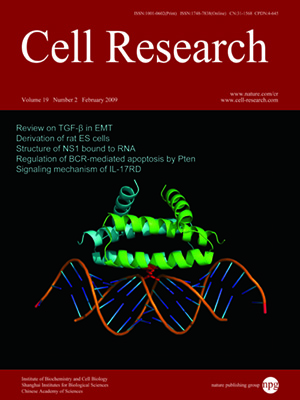
Volume 19, No 2, Feb 2009
ISSN: 1001-0602
EISSN: 1748-7838 2018
impact factor 17.848*
(Clarivate Analytics, 2019)
Volume 19 Issue 2, February 2009: 173-186
ORIGINAL ARTICLES
Derivation and transcriptional profiling analysis of pluripotent stem cell lines from rat blastocysts
Chunliang Li1,4,*, Ying Yang1,4,*, Junjie Gu1,2,3, Yu Ma1,2,3 and Ying Jin1,2,3
1Key Laboratory of Stem Cell Biology, Institute of Health Sciences, Shanghai Institutes for Biological Sciences, Chinese Academy of Sciences/Shanghai Jiao Tong University School of Medicine; 225 South Chongqing Road, Shanghai 200025, China;
2Shanghai Stem Cell Institute, Shanghai Jiao Tong University School of Medicine, Shanghai 200025, China;
3Key Laboratory of Cell Differentiation and Apoptosis of Chinese Ministry of Education, Shanghai Jiao Tong University School of Medicine, Shanghai 200025, China;
4Graduate School of Chinese Academy of Sciences, Beijing 100049, China
Correspondence: Ying Jin,(yjin@sibs.ac.cn)
Embryonic stem (ES) cells are derived from blastocyst-stage embryos. Their unique properties of self-renewal and pluripotency make them an attractive tool for basic research and a potential cell resource for therapy. ES cells of mouse and human have been successfully generated and applied in a wide range of research. However, no genuine ES cell lines have been obtained from rat to date. In this study, we identified pluripotent cells in early rat embryos using specific antibodies against markers of pluripotent stem cells. Subsequently, by modifying the culture medium for rat blastocysts, we derived pluripotent rat ES-like cell lines, which expressed pluripotency markers and formed embryoid bodies (EBs) in vitro. Importantly, these rat ES-like cells were able to produce teratomas. Both EBs and teratomas contained tissues from all three embryonic germ layers. In addition, from the rat ES-like cells, we derived a rat primitive endoderm (PrE) cell line. Furthermore, we conducted transcriptional profiling of the rat ES-like cells and identified the unique molecular signature of the rat pluripotent stem cells. Our analysis demonstrates that multiple signaling pathways, including the BMP, Activin and mTOR pathways, may be involved in keeping the rat ES-like cells in an undifferentiated state. The cell lines and information obtained in this study will accelerate our understanding of the molecular regulation underlying pluripotency and guide us in the appropriate manipulation of ES cells from a particular species.
Cell Research (2009) 19:173-186. doi: 10.1038/cr.2008.301; published online 4 November 2008
FULL TEXT | PDF
Browse 1883


